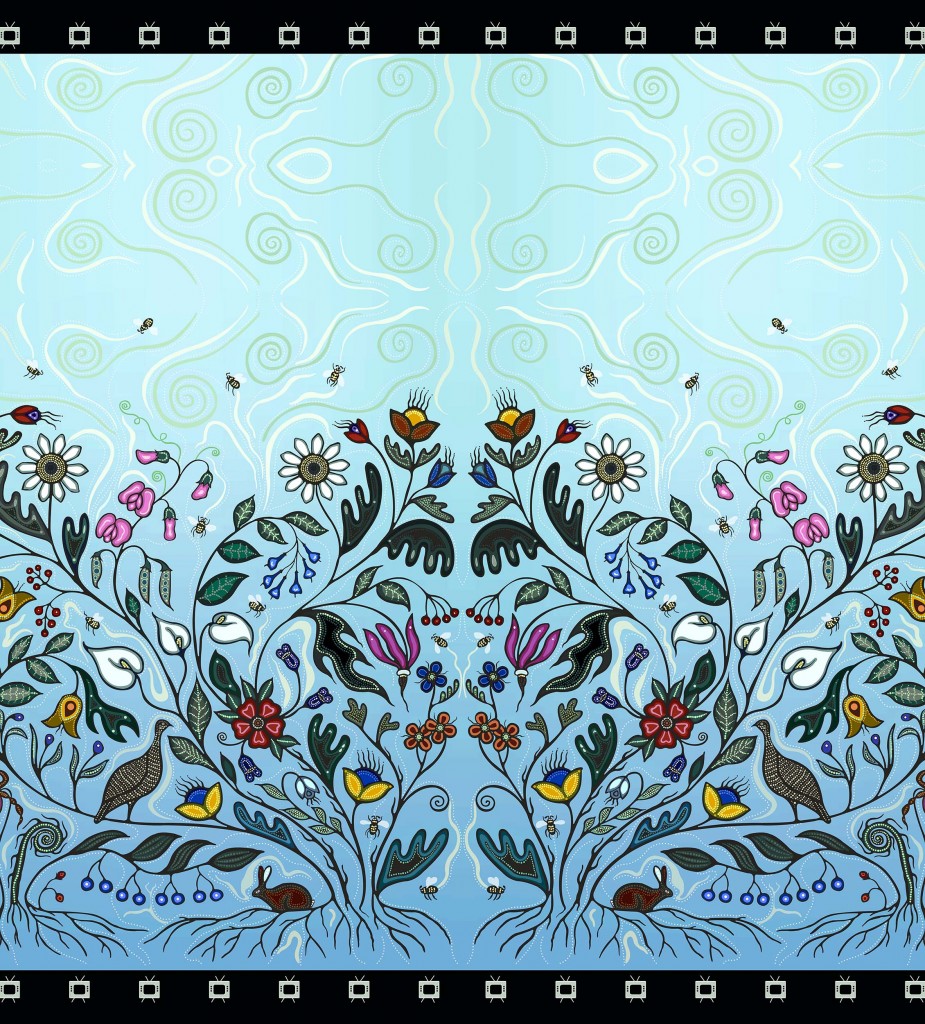Christi Belcourt – Painter
The painting “What We Teach Our Children” was painted in 2008 in honour of children, inspired by my daughter Jeana who was 10 years old at the time.
Within the painting there are several important elements: bees, plants, roots, animals, the spirit world & televisions.
Bumble bees in the painting represent the uncertain future. They are there as a reminder of environmental abuse of Mother Earth and questions what kind of world we are leaving to our children. The bumble bees are disappearing in North America, mostly due to human impacts on their populations. Bees are vitally important to crop pollination, food supply, agriculture and the economy – without them we all suffer.
Plants represent hope and renewal. Plants are our “first family” – they come first because none of us (animals, insects or human beings) can survive without them. Plants are spiritual beings whose lives must be honoured and respected. All plants have medicinal qualities. In this painting there are shooting star, daisy, bluebells, pink lady slipper, solomon’s seal, choke cherries, sweet pea, wild rose, strawberry and calla lilies. The calla lilies and strawberries are in the painting as a reminder of the stage of puberty that kids will enter into after the middle years. Its about being prepared as parents to bring our kids into that stage in a healthy way. The pink lady slipper is there because it reminds us about the fragility of life – this plant only flowers after 10 years and will die if the flower is picked. The choke cherries remind us of our grandmothers and the work of women picking berries and plants.
The partridge and the rabbit are there because of something my Elder Maria Campbell said about how young children were taught to hunt by their grandmothers. It was grandmothers who would take the younger children out to learn how to snare rabbits, partridges and other small animals. Grandmothers taught the children important lessons on respect and the protocols that have to be observed in nature. These lessons were the foundation for boys when they were old enough to join the men hunting, they would already know these protocols.
The partridge and rabbit therefore represents within the painting how it is children learn – and the importance of Elders in the role of teaching children. This bond between elder and child was a way to ensure children learned from the wisdom of Elders. In our modern day, this bond has been broken. It is rare, especially for our kids in urban areas, to be raised or taught by their grandparents. So the partridge and rabbit are there to remind us to question how our children are being raised – who is teaching them – and what are they missing that they would be getting if they had the chance to learn from Elders on a daily basis?
Roots in the painting are a metaphor for our ancestry and spiritual lives. Roots are not seen, but are essential to the strength and life of the plant or tree. Our ancestry has great influence in our lives, in how we see things and relate to the world. Our spirits are often forgotten about in our busy lives because we don’t see them – and this can lead us to neglect our spirits and put ourselves out of balance because we tend to focus too much on the physical, mental or emotional side of our beings. Roots are in my paintings to remind me of the sacrifices my ancestors made for me, they are there to remind me to care for what I cannot see.
As with the roots, the swirls and dots in the sky is the spirit world. In the painting the spirit world is present, moving, changing and interacting with the animal and plant world – and by extension – us.
The television in the borders are there to remind us to be diligent about who and what is teaching our children. We need to take the time needed to give our kids the teachings and exposure to traditional ways. In the old ways, our grandfathers and grandmothers would be the primary teachers for our children. But this bond has been broken – our modern lives simply don’t support this concentrated learning anymore. Our kids go to school to learn from strangers. They play video games. They watch TV. This leads me to question – who is teaching my daughter? Whose culture is she learning? How will she know how to be Anishnaabe and Metis if I’m not taking the time to teach her and if I’m not mindful of finding a balance between the “entertainment” she seeks, and the “culture” I want her to learn.

